

Have you tried homemade croissants yet?
Today I’m sharing a croissant variation. Am I allowed to admit that these are even better than the original? Ultra thin layers. Buttery crispness. Melted chocolate. Confectioners’ sugar dusting. Simple. Decadent. There’s absolutely nothing on earth better than a warm chocolate croissant unless that warm chocolate croissant was proudly handmade in your own kitchen.
You’ve come to the right place today. 🙂
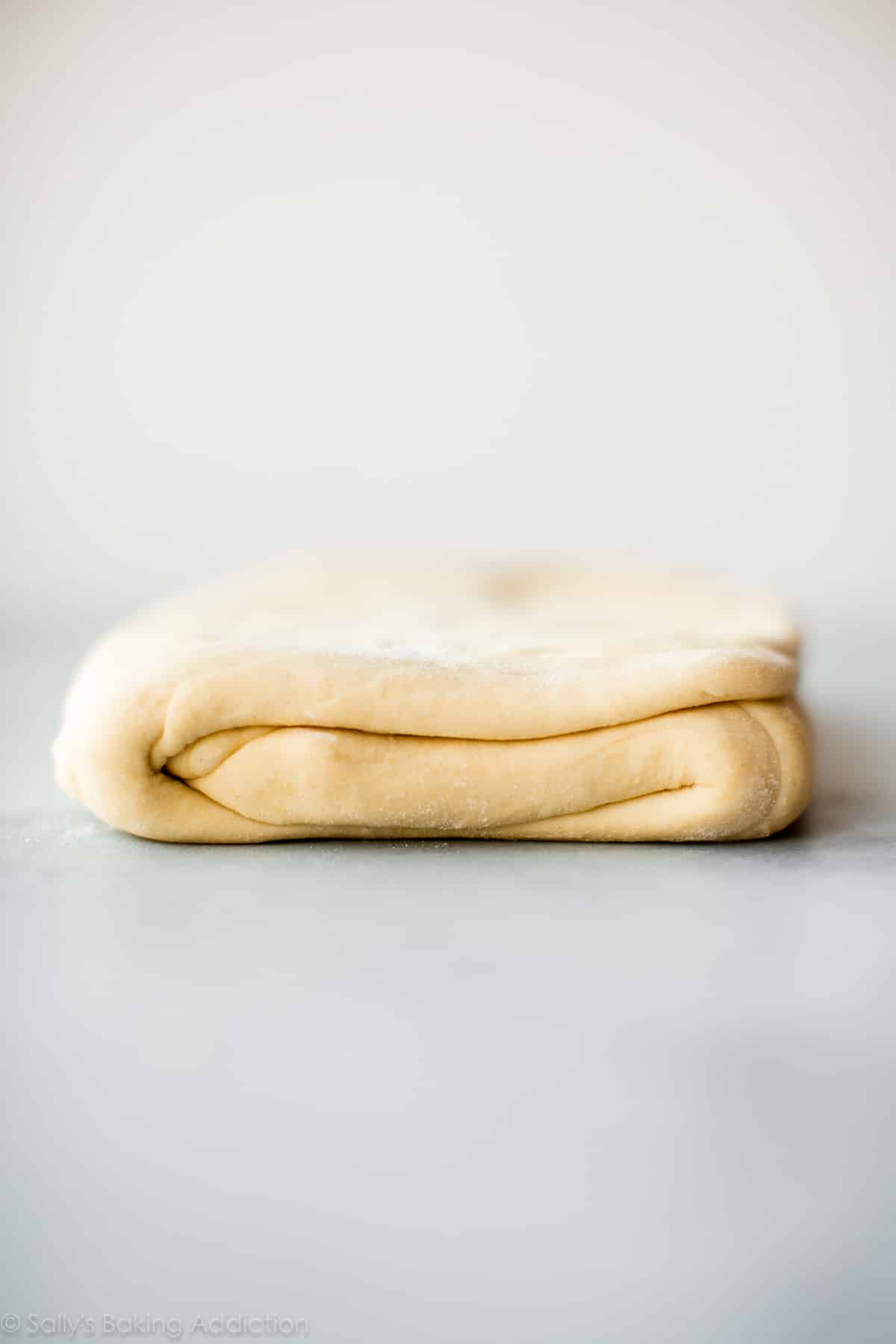
I’m not going into specifics today since I typed a novel about croissants the other week. Rather, we’ll focus our attention on rolling the croissants with chocolate. We’re starting with the same exact croissant dough. I talk about this a lot in the croissants recipe, but it’s worth repeating: croissant dough must remain cold and requires a lot of resting. Because of all that rest, there’s a time commitment to making this pastry. Which is why croissants are a delicious weekend project!
You’ll complete steps 1-12 in the original croissants recipe. Things change when it’s time to shape the dough. Once your dough has finished the 2nd 4 hour rest, roll and shape it into a long 8×20-inch rectangle. Use your pizza cutter and slice the rectangle down the center to create two 4×20-inch rectangles. Then slice across 3x to create eight 4×5-inch rectangles.
So far, this is exactly what you do when you make the original croissants.
Instead of slicing each of those rectangles diagonally into triangles, you’ll cut them in half to create 16 smaller rectangles.
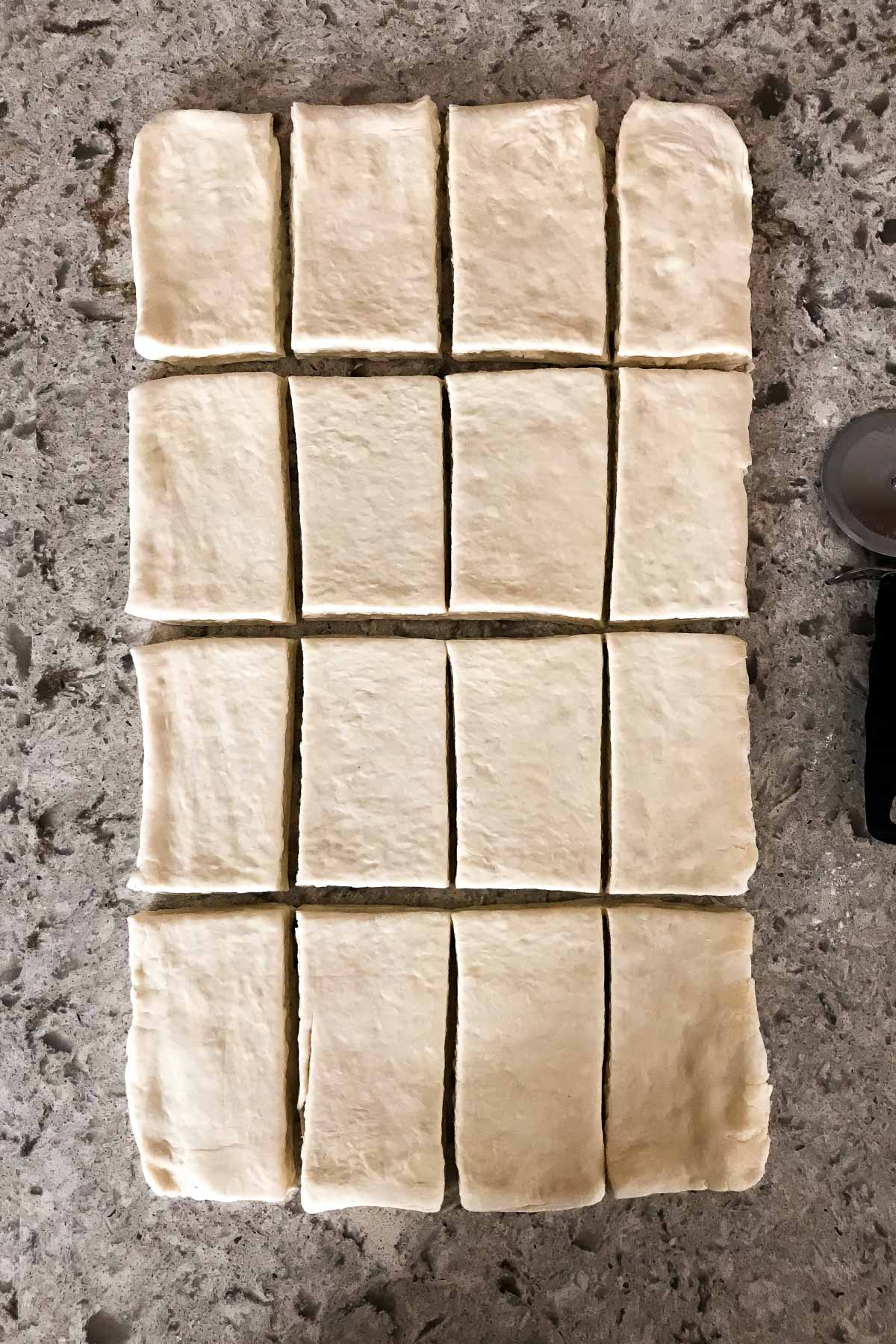
You could definitely keep the same triangle shape as we do with regular croissants, but the rectangle shape protects the chocolate from oozing out too much. And you can fit more chocolate inside. 🙂
Speaking of chocolate!
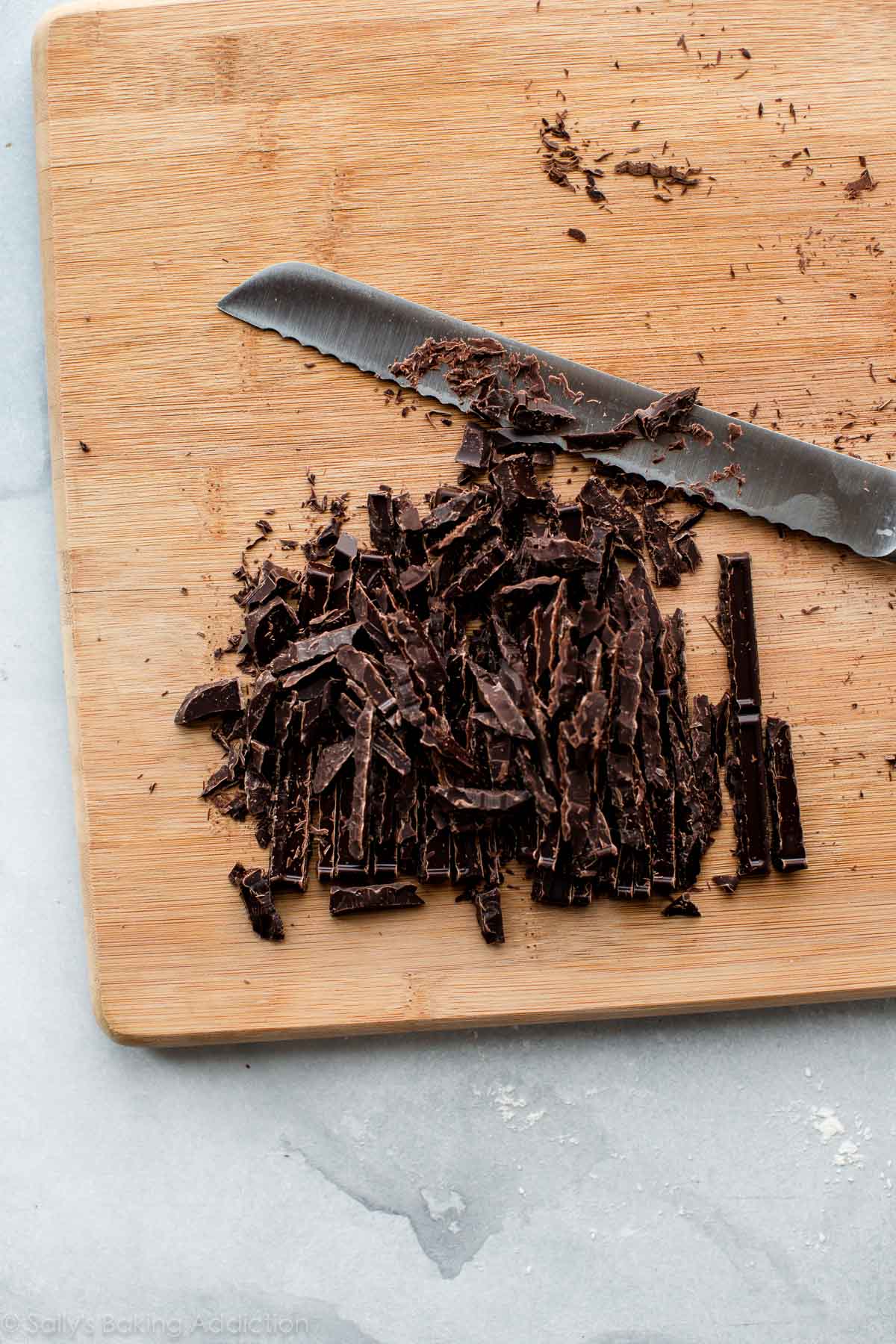
There are special conveniently sized chocolate batons you can purchase—just search the internet for chocolate batons—but I’d rather use the same chocolate I use for everything else: baking chocolate. I just buy it at the grocery store. You can use any brand of baking chocolate you like best, but I prefer the thinness of Ghirardelli’s baking bars. They slice thinly and neatly, fitting snug inside the croissant dough.
I like to use a darker chocolate like bittersweet or semi-sweet.
Now let’s roll up the chocolate croissants. Take each rectangle and gently stretch it out with your hands to be 8 inches long. Place a few pieces of chocolate at one end and roll it up tightly inside.
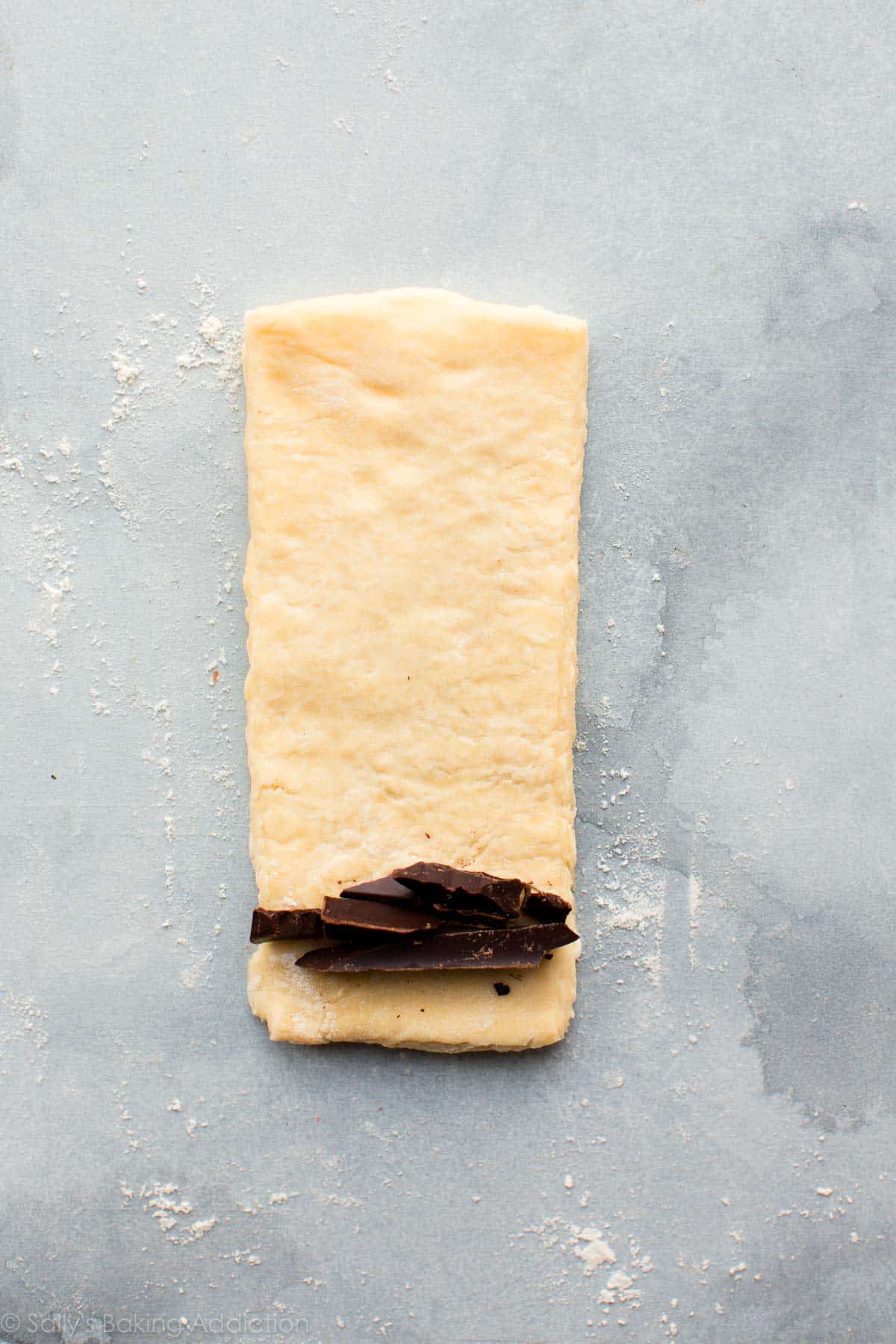
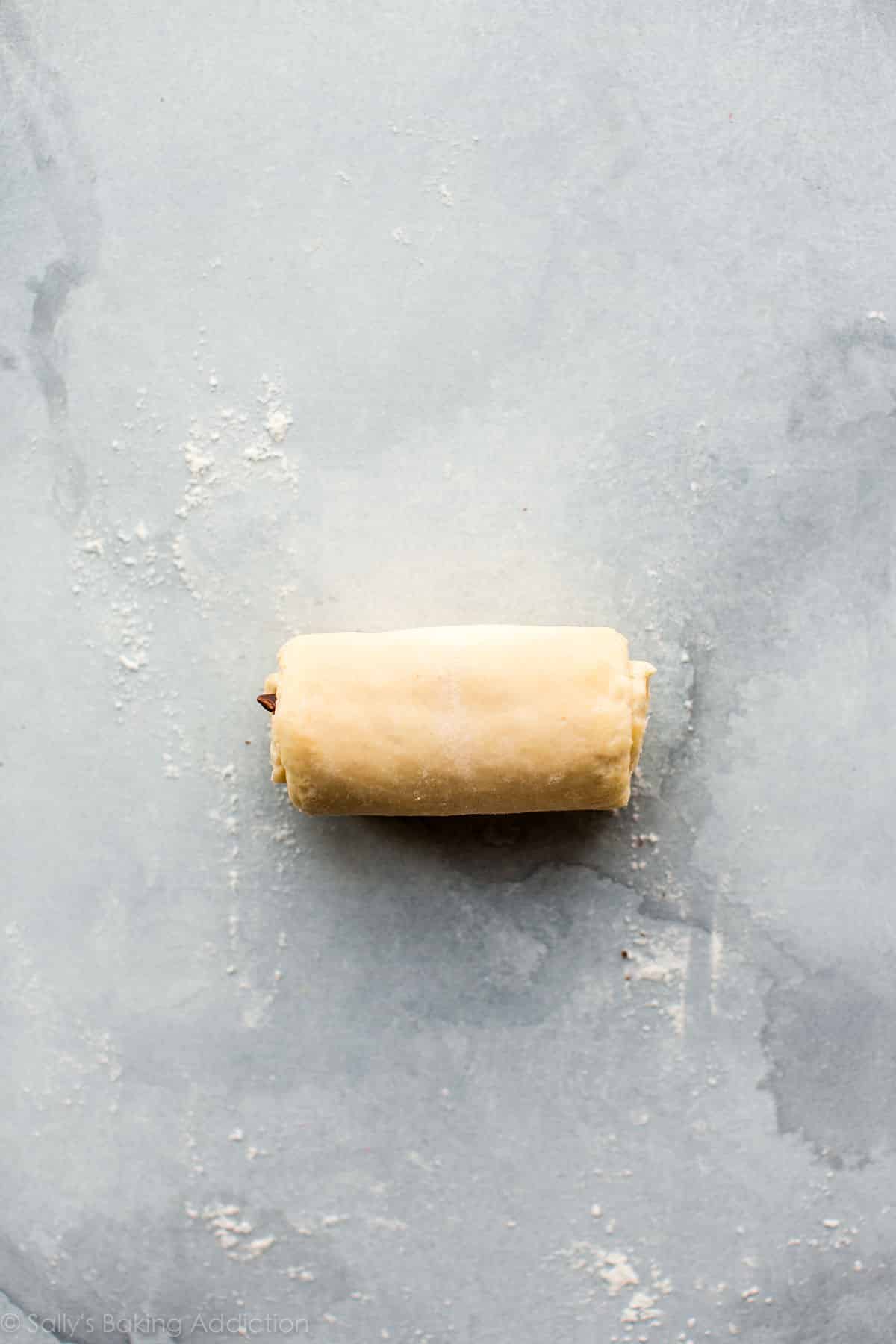
Like a little sleeping bag for chocolate!
We’re back to the original croissant recipe from here on out. Allow the shaped chocolate croissants to proof at room temperature for 1 hour, then continue in the refrigerator for another. I prefer the shaped chocolate croissants to be cold going in the oven because they won’t spread as much. The chocolate croissants will rise and proof at room temperature and continue to do so in the refrigerator.
After this time, they’ll be a little more puffy and ready to bake.
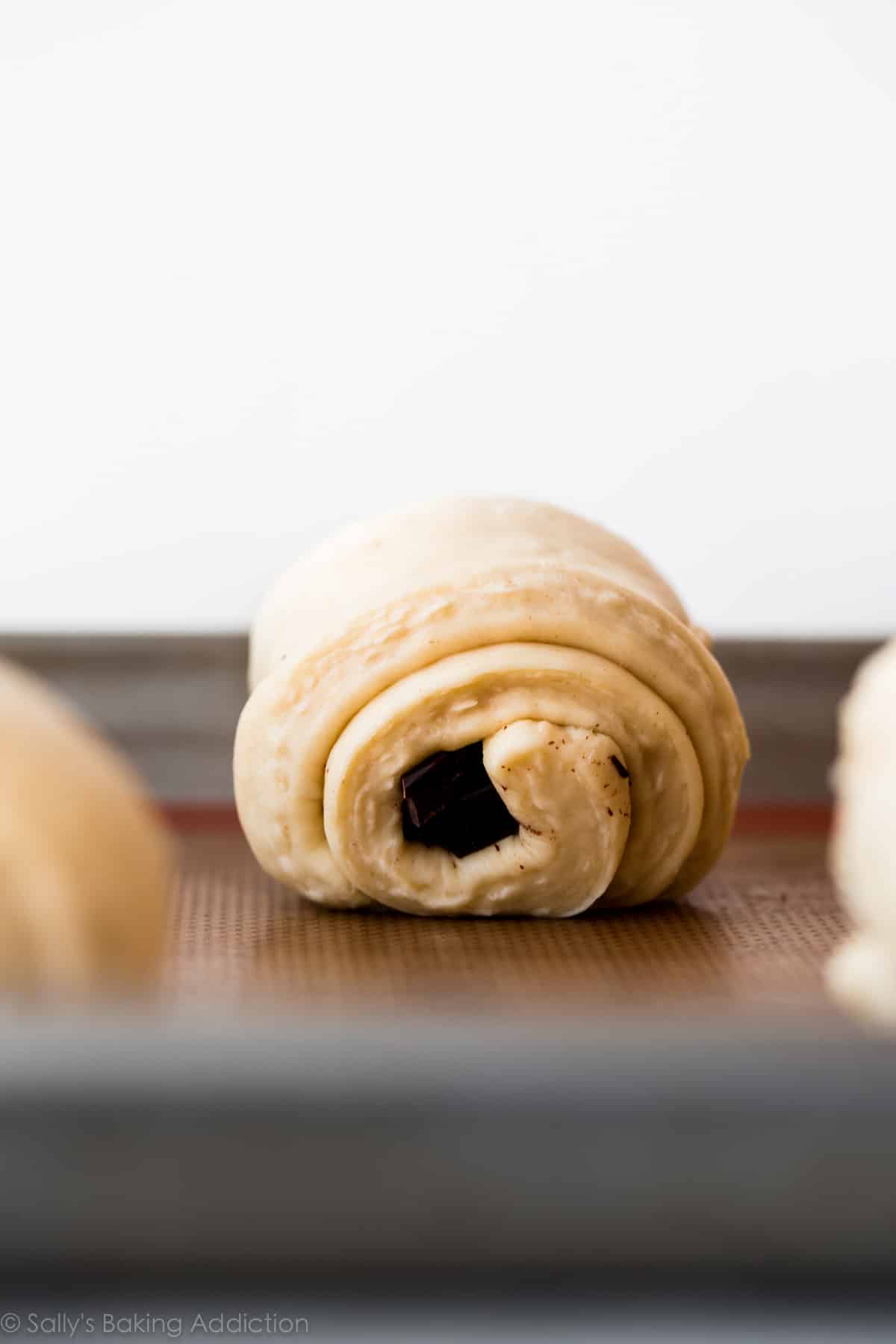
Brush them with an egg wash and 20 minutes later, you’ll understand the hype. Like I said before, there’s absolutely nothing better than a homemade fresh croissant filled with a river of melted chocolate. They’re golden brown with hundreds of crisp flaky layers (and that’s from a dough we laminated 3x!).
A snow shower of confectioners’ sugar is necessary.


Chocolate croissants, or pain au chocolat in French!
If you don’t feel *quite* ready to tackle croissants, you can also make a loaf of croissant bread with slightly shorter rest times and easier shaping.
Print
Homemade Chocolate Croissants (Pain au Chocolat)
- Prep Time: 12 hours, 45 minutes
- Cook Time: 20 minutes
- Total Time: 13 hours, 10 minutes
- Yield: 16 croissants
- Category: Pastries
- Method: Baking
- Cuisine: French
Description
Extra flaky and buttery homemade chocolate croissants (Pain au Chocolat) are incredible warm from the oven. Recreate this French bakery classic at home!
Ingredients
- 1/4 cup (4 Tbsp; 56g) unsalted butter, softened to room temperature
- 4 cups (500g) all-purpose flour (spooned & leveled), plus more for rolling/shaping
- 1/4 cup (50g) granulated sugar
- 2 teaspoons salt
- 1 Tablespoon active dry or instant yeast
- 1 and 1/2 cups (360ml) cold whole milk
- one 4-ounce bar (113g) semi-sweet or bittersweet chocolate, coarsely chopped
- optional: confectioners’ sugar for dusting
Butter Layer
- 1 and 1/2 cups (340g) unsalted butter, softened to room temperature
- 2 Tablespoons (16g) all-purpose flour
Egg Wash
- 1 large egg
- 2 Tablespoons (30ml) whole milk
Instructions
- Preliminary notes: I have lots of information to prepare you to make homemade chocolate croissants. A complete guide to making the croissant dough, with a video and step-by-step photographs, can be found in my original croissants recipe. That post will help you get through the first several steps. Additionally, you can see the post above for a visual for how the chocolate croissants are shaped, which begins in step 13 below. Make room in the refrigerator for a baking sheet. In step 6 and again in step 13, you will need room for 2 baking sheets.
- Make the dough: Cut the butter in four 1-Tablespoon slices and place in the bowl of an electric stand mixer fitted with the dough hook attachment (or you can use a handheld mixer or no mixer, but a stand mixer is ideal). Add the flour, sugar, salt, and yeast. Turn the mixer on low-medium speed to gently combine the ingredients for 1 minute. With the mixer running, slowly pour in the milk. Once all of the milk is added, turn the mixer up to medium speed and begin to knead the dough.
- Knead the dough: Keep the dough in the mixer and beat for an additional 5 full minutes, or knead by hand on a lightly floured surface for 5 full minutes. (If you’re new to bread-baking, my How to Knead Dough video tutorial can help here.) If the dough becomes too sticky during the kneading process, sprinkle 1 teaspoon of flour at a time on the dough or on the work surface/in the bowl to make a soft, slightly tacky dough. Do not add more flour than you need because you do not want a dry dough. After kneading, the dough should still feel a little soft. Poke it with your finger—if it slowly bounces back, your dough is ready to rest. You can also do a “windowpane test” to see if your dough has been kneaded long enough: tear off a small (roughly golfball-size) piece of dough and gently stretch it out until it’s thin enough for light to pass through it. Hold it up to a window or light. Does light pass through the stretched dough without the dough tearing first? If so, your dough has been kneaded long enough and is ready to rest. If not, keep kneading until it passes the windowpane test.
- Remove dough from the bowl and, with floured hands, work it into a ball. Place the dough on a lightly floured silicone baking mat lined, lightly floured parchment paper lined, or lightly floured baking sheet. (I recommend a silicone baking mat because you can roll the dough out in the next step directly on top and it won’t slide all over the counter.) Gently flatten the dough out, and cover with plastic wrap or aluminum foil. Place the entire baking sheet in the refrigerator and allow the covered dough to rest in the refrigerator for 30 minutes.
- Shape the dough: Remove the dough from the refrigerator. I like to keep the dough on the silicone baking mat when I’m rolling it in this step because the mat is nonstick and it’s a handy guide for the exact measurement. Begin flattening out the dough with your hands. You’re rolling it out into a rectangle in this step, so shaping it with your hands first helps the stretchy dough. Roll it into a 14×10-inch rectangle. The dough isn’t extremely cold after only 30 minutes in the refrigerator, so it will feel more like soft play-doh. Be precise with the measurement. The dough will want to be oval shaped, but keep working the edges with your hands and rolling pin until you have the correct size rectangle.
- Long rest: Place the rolled out dough back onto the baking sheet (this is why I prefer a silicone baking mat or parchment because you can easily transfer the dough). Cover the rolled out dough with plastic wrap or aluminum foil, place the entire baking sheet in the refrigerator and allow the covered dough to rest in the refrigerator for 4 hours or overnight. (Up to 24 hours is ok.)
- Butter layer (begin this 35 minutes before the next step so the butter can chill for 30 minutes): In a large bowl using a hand-held mixer or stand mixer fitted with a paddle or whisk attachment, beat the butter and flour together until smooth and combined. Transfer the mixture to a silicone baking mat lined or parchment paper lined baking sheet. (Silicone baking mat is preferred because you can easily peel the butter off in the next step.) Using a spoon or small spatula, smooth out into a 7×10-inch rectangle. Be as precise as you can with this measurement. Place the entire baking sheet in the refrigerator and chill the butter layer for 30 minutes. (No need to cover it for only 30 minutes.) You want the butter layer firm, but still pliable. If it gets too firm, let it sit out on the counter for a few minutes to gently soften. The more firm the butter layer is the more difficult it will be to laminate the dough in the next step.
- Laminate the dough: In this next step, you will be rolling out the dough into a large rectangle. Do this on a lightly floured counter instead of rolling out on your silicone baking mat. The counter is typically a little cooler (great for keeping the dough cold) and the silicone baking mat is smaller than the measurement you need. Remove both the dough and butter layers from the refrigerator. Place the butter layer in the center of the dough and fold each end of the dough over it. If the butter wasn’t an exact 7×10-inch rectangle, use a pizza cutter or sharp knife to even out the edges. Seal the dough edges over the butter layer as best you can with your fingers. On a lightly floured counter, roll the dough into a 10×20-inch rectangle. It’s best to roll back and forth with the shorter end of the dough facing you. Use your fingers if you need to. The dough is very cold, so it will take a lot of arm muscle to roll. Again, the dough will want to be oval shaped, but keep working it with your hands and rolling pin until you have the correct size rectangle. Fold the dough lengthwise into thirds as if you were folding a letter. This was the 1st turn.
- If the dough is now too warm to work with, place folded dough on the baking sheet, cover with plastic wrap or aluminum foil, and refrigerate for 30 minutes before the 2nd turn. I usually don’t have to.
- 2nd turn: Turn the dough so the short end is facing you. Roll the dough out once again into a 10×20-inch rectangle, then fold the dough lengthwise into thirds as if you were folding a letter. The dough must be refrigerated between the 2nd and 3rd turn because it has been worked with a lot by this point. Place the folded dough on the baking sheet, cover with plastic wrap or aluminum foil, and refrigerate for 30 minutes before the 3rd turn.
- 3rd turn: Roll the dough out once again into a 10×20-inch rectangle. Fold the dough lengthwise into thirds as if you were folding a letter.
- Long rest: Place the folded dough on the lined baking sheet, cover with plastic wrap or aluminum foil, and refrigerate for 4 hours or overnight. (Up to 24 hours is ok.)
- At the end of the next step, you’ll need 2 baking sheets lined with silicone baking mats or parchment paper. The dough is currently on a lined baking sheet in the refrigerator, so you already have 1 prepared!
- Shape the croissants: Remove the dough from the refrigerator. On a lightly floured counter, roll the dough out into an 8×20-inch rectangle. Use your fingers if you need to. Once again, the dough is very cold, so it will take a lot of arm muscle to roll. The dough will want to be oval shaped, but keep working it with your hands and rolling pin until you have the correct size rectangle. Using a pizza cutter or sharp knife, slice the dough in half vertically. Each skinny rectangle will be 4 inches wide. Then cut 3 even slices horizontally, yielding 8 4×5-inch rectangles. See photo above for a visual. Cut each rectangle in half lengthwise so you have 16 2×5-inch rectangles. Work with one rectangle at a time. Using your fingers or a rolling pin, stretch it to be about 8 inches long. Do this gently as you do not want to flatten the layers. Place a few small pieces of chocolate in a single layer at one end and tightly roll the dough up around the chocolate. Make sure the end is on the bottom. Repeat with remaining dough, placing the shaped croissants on 2 lined baking sheets, 8 per sheet. Loosely cover with plastic wrap or aluminum foil and allow to rest at room temperature (no warmer! I suggest just keeping on the counter) for 1 hour, then place in the refrigerator to rest for 1 hour or up to 12 hours. (Or freeze, see freezing instructions. I prefer the shaped croissants to be cold going into the oven.
- Preheat oven to 400°F (204°C).
- Egg wash: Whisk the egg wash ingredients together. Remove the croissants from the refrigerator. Brush each lightly with egg wash.
- Bake the croissants: Bake until croissants are golden brown, about 20 minutes. Rotate the pans halfway through baking. If croissants show signs of darkening too quickly, reduce the oven to 375°F (190°C).
- Remove chocolate croissants from the oven and place on a wire rack to cool for a few minutes before serving. They will slightly deflate as they cool. If desired, dust with confectioners’ sugar before serving.
- Croissants taste best the same day they’re baked. Cover any leftover croissants and store at room temperature for a few days or in the refrigerator for up to 1 week. You can also freeze for up to 3 months, then thaw on the counter or overnight in the refrigerator. Warm up to your liking.
Notes
- Make Ahead Instructions: Croissants are perfect for getting started ahead of time. The dough can rest for 4 hours or overnight in step 5 and again in step 11. You can also freeze the dough after the 3rd turn in the lamination process (after step 10). Instead of the 4 hour rest in the refrigerator in step 11, wrap the dough tightly in plastic wrap or aluminum foil, place in a freezer zipped-top bag, and freeze for up to 3 months. Thaw in the refrigerator and continue with step 12. You can also freeze the shaped croissants after they rest for 1 hour at room temperature in step 13. (Before placing in the refrigerator.) Cover them tightly and freeze for up to 1 month. Thaw completely in the refrigerator, then bake as directed.
- Special Tools (affiliate links): Stand Mixer (preferred), Hand Mixer, or Glass Mixing Bowl with Wooden Spoon / Silicone Spatula | Rolling Pin | Pizza Cutter | Pastry Brush | Silicone Baking Mat or Parchment Paper | Baking Sheet | Cooling Rack
- Yeast: I use and recommend Red Star Platinum, an instant yeast. Reference my Baking with Yeast Guide for answers to common yeast FAQs.
- Chocolate: You can find 4 ounce chocolate baking bars in the baking aisle. I recommend using Ghirardelli brand because the bars are thin and the thin pieces roll up neatly in the croissant dough. I use bittersweet chocolate, but you can use milk chocolate, semi-sweet, or darker chocolate.
- Keep Dough Cold: Make sure the dough is ALWAYS cold. If it warms up too much, stop what you’re doing and place the dough back in the refrigerator for 20 minutes.
- Floured Surface: Lightly flour the work surface, your hands, the dough, and the rolling pin as you work.
- Air Bubbles: If there are air bubbles in your dough, pop them with your fingers or a toothpick, then lightly flour where you popped the air bubble.
- Croissants for Brunch: I recommend starting the recipe the day before in the early afternoon. Complete steps 1-10, then let the laminated dough have a long rest in the refrigerator overnight (step 11). Begin step 13 2-3 hours before brunch.
- Dough adapted from Joy of Baking, Food & Wine, and Epicurious





















Can i use any other fillings for these? Raspberries ? Almond paste?
Absolutely!
Just made this recipe, and wow!! It was absolutely amazing!! My husband ate 6 within 5 minutes and had to refrain himself from eating the rest. This satisfied my cravings and exceeded my expeditions for making such a dessert for the first time. Highly recommend and will be making again!
Made these for my family and neighbors when our power was restored post Hurricane Helene and everyone said they were addictive! I made half plain, half chocolate 100% loved by all. I used lactose free milk & I can’t believe it’s not butter with no issues. Neighbors and I have lactose/Dairy intolerances. I used Great Value mini semi sweet chips as that’s all we had post hurricane but they worked! I’ll probably add more chocolate next time lol Also a YouTube video showed me how to shape the croissants with an Eiffel tower method which made it easier!
Oh. my. gosh. THESE WERE SO GOOD!!!
I’m not a super talented baker, and I think i messed up a little bit with the lamination, but these are delicious. I will 100% be making these again
Sally, Cna I shorten any of the final steps so
I can get these in the oven? Possible change the last refrigeration to 2 or 3 1-2 hours or the resting on the counter and then refrigerator? Just to be clear I am making the chocolate version. I think I am going to use Ghirardelli bittersweet chocolate chips? Is that ok? Should I cut them up?
Hi Debbie, are you referring to the final rest in step 14? We suggest just keeping the shaped croissants on the counter for 1 hour, then place in the refrigerator to rest for 1 hour or up to 12 hours. You’ll want the shaped croissants to be cold going into the oven. We prefer real chocolate baking bars for the best texture. Most chocolate chips contain stabilizers to help them hold their shape (perfect in cookies!) but prevents them from melting evenly. However, Ghirardelli chocolate chips will usually melt better than other brands, so if that’s all you have, you can certainly try using them. No need to chop them up, although you can if you wish.
Currently waiting for my dough in the refrigerator but I had to use closer to 5 cups of flour. Maybe not a full cup more but my dough was super sticky still and not pulling from the bowl. Maybe it’s just humid here? Did I do something wrong?
Hi Abby, There are a lot of variances that go into the consistency of dough from day to day, even down to the weather and humidity in the air. If you find that the dough is overly sticky and is tearing as you work with it, sprinkle more and more flour on it as you shape it and roll it out. If at any point the dough/butter layer seem to get too warm (like the butter is spilling out the sides and is too soft), stop what you are doing and refrigerate it for 15-20 minutes before continuing. Hope this is helpful for next time!
Hey Sally! I’ve made a lot of your recipes and most of them turn out absolutely delicious! But I have not been able to get the texture right for the croissants or for a loaf of bread. It always turns out too dense and seems undercooked on the inside, but just right in the outside. Any tips to get a lighter, fluffier bread? (I’ve tried turning oven temp down and increasing baking time too, but the inside still seemed to dense and doughy).
Hi Kensi, we’re happy to help troubleshoot! When yeasted doughs turn out too dense, it’s usually a matter of over kneading, which over develops the gluten in the bread. This How to Knead Dough tutorial will be helpful to review and give you a better idea of how to know when the dough has been sufficiently kneaded. Our Baking with Yeast guide will be helpful, too. Thank you for making and trusting our recipes!
I feel like my yeast didnt really get mixed in… like I can see little pieces of it here and there throughout my dough…. Did I do anything wrong?